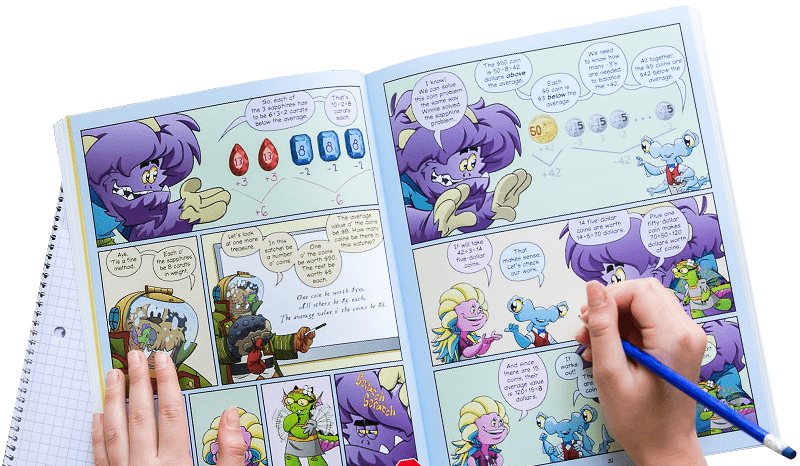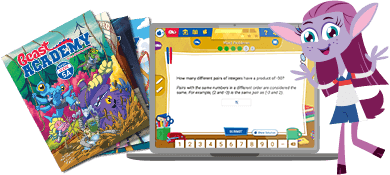Wrecking Ball
Make your own pendulum, then get set to wreck with this simple addition and subtraction game!
Instructions
Before you play, you'll need to make a pendulum (your "wrecking ball"). Attach one end of a string somewhere at least a few feet off the ground. We attached ours to a dining table using tape.
Some other options: tie one end to a branch, or attach one end to the top of a door frame. Just make sure that your string is fairly secure, and that there's room at the bottom for your pendulum to swing around without hitting (or breaking!) anything.
At the bottom of the string, attach a weight. We used a spoon and some tape. Measuring spoons or small measuring cups work well because they often have a little hole you can tie the string through.
Attach the weight so that, when it's hanging still, it's just a little bit off the ground.
Now set up 3 blocks or other items labeled 1, 3, and 9. (Don't choose other numbers. These numbers are special because we can combine them in different ways with addition and subtraction to get every number we'll need for the game. See Learning Notes below for more on this.) We used dominoes, but blocks, paper cups, or anything knock-downable will work. Set these up so that they can be hit by the pendulum. The farther apart they are from each other, the harder the game.

Next, make a score card for each player by writing the numbers 1-13 down the side of a piece of paper. (Or, for a shorter, non-competitive game, make one score card to share. See the Collaborative Play variation below.)

Now it's time to wreck! Take turns swinging the pendulum to knock down the numbers. Swing up to three times on your turn. You can knock down one block per swing. (Or, for an easier variation, allow multiple blocks to be knocked down on a single swing. See Variations below for more ideas!)

Use addition or subtraction (or both!) to combine the numbers you hit. Write this on your score card. Then, cross off the resulting number. For example, if you hit 3 and 9, you could write 9 + 3 = 12 and cross off the 12, or you could write 9 - 3 = 6 and cross off the 6.

What numbers could you cross off your score card if you hit the 1, 3, and 9? You could write 9 + 1 - 3 = 7, for example, but there are other possibilities. Figuring out how to cross off each number on your score card is part of the fun!
When you knock down only one number, it's still best to record this with an equation. If you knock down the 3, write 3 = 3 on your score card before you cross off the 3. (See Equations below for why equations like this are worth writing down.)
The first player to cross off all their numbers, 1 to 13, wins!

Don't forget: it's Beast Academy Playground, not Beast Academy Study Hall. Change the rules, be silly, make mistakes, and try again. The Variations and Learning Notes are here for you if you want to dive deeper, but not all of them apply to learners of every age. The most important thing is to have fun.
What do you think of this activity?
We're always looking to improve. Submit your feedback to us below.
- string
- something to tie on (we used a spoon)
- 3 items to knock down (we used dominoes)
- paper
- pencil
- addition
- subtraction
- writing numbers
- MP7
- K.CC.A.2
- K.CC.A.3
- K.OA.A.1
- K.OA.A.3
- 1.OA.C.5
- 1.OA.C.6
- 1.OA.D.7

Ready to level up?
Keep problem solving with Beast Academy’s full math curriculum for students ages 6–13. Check out our captivating comic book series and immersive online platform.
LEARN MOREBring problem-solving to your classroom
Keep your entire class engaged with a full book and online math curriculum, for students ages 6–13. 98% of teachers say they’re satisfied with Beast Academy.
LEARN MORE



Ready to level up?
Keep problem solving with Beast Academy’s full math curriculum for students ages 6–13. Check out our captivating comic book series and immersive online platform.
LEARN MOREBring problem-solving to your classroom
Keep your entire class engaged with a full book and online math curriculum, for students ages 6–13. 98% of teachers say they’re satisfied with Beast Academy.
LEARN MORE
Sign up to be notified when new videos are released.
















































